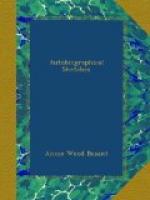At last I said to Mr. Scott: “Mr. Scott, may I write a tract on the nature and existence of God?”
He glanced at me keenly: “Ah, little lady; you are facing then that problem at last? I thought it must come. Write away.”
The thought that had been driving me forward found its expression in the opening words of the essay (published a few months later, with one or two additions that were made after I had read two of Mr. Bradlaugh’s essays, his “Plea for Atheism”, and “Is there a God?"): “It is impossible for those who study the deeper religious problems of our time to stave off much longer the question which lies at the root of them all, ’What do you believe in regard to God?’ We may controvert Christian doctrines one after another; point by point we may be driven from the various beliefs of our churches; reason may force us to see contradictions where we had imagined harmony, and may open our eyes to flaws where we had dreamed of perfection; we resign all idea of a revelation; we seek for God in Nature only: we renounce for ever the hope (which glorified our former creed into such alluring beauty) that at some future time we should verily ‘see’ God; that ‘our eyes should behold the King in his beauty’, in that fairy ‘land which is very far off’. But every step we take onwards towards a more reasonable faith and a surer light of Truth, leads us nearer and nearer to the problem of problems: ’What is THAT which men call God?”.
I sketched out the plan of my essay and had written most of it when on returning one day from the British Museum I stopped at the shop of Mr. Edward Truelove, 256 High Holborn. I had been working at some Comtist literature, and had found a reference to Mr. Truelove’s shop as one at which Comtist publications might be bought. Lying on the counter was a copy of the National Reformer, and attracted by the title I bought it. I had never before heard of nor seen the paper, and I read it placidly in the omnibus; looking up, I was at first puzzled and then amused to see an old gentleman gazing at me with indignation and horror printed on his countenance; I realised that my paper had disturbed his peace of mind, and that the sight of a young woman, respectably dressed in crape, reading an Atheistic journal in an omnibus was a shock too great to be endured by the ordinary Philistine without sign of discomposure. He looked so hard at the paper that I was inclined to offer it to him for his perusal, but repressed the mischievous inclination, and read on demurely.
This first copy of the paper with which I was to be so closely connected bore date July 19th, 1874, and contained two long letters from a Mr. Arnold of Northampton, attacking Mr. Bradlaugh, and a brief and singularly self-restrained answer from the latter. There was also an article on the National Secular Society, which made me aware that there was an organisation devoted to the propagandism of Free Thought. I felt that if such a society existed, I ought to belong to it, and I consequently wrote a short note to the editor of the National Reformer, asking whether it was necessary for a person to profess Atheism before being admitted to the Society. The answer appeared in the National Reformer:—




